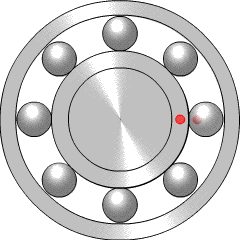
The circulatory system, also called the cardiovascular system or the vascular system, is an organ system that permits blood to circulate and transport nutrients, oxygen, carbon dioxide, hormones, and blood cells to and from the cells in the body to provide nourishment and help in fighting diseases, stabilize temperature and pH, and maintain homeostasis.

A ball bearing is a type of rolling-element bearing that uses balls to maintain the separation between the bearing races.
An actuator is a component of a machine that is responsible for moving and controlling a mechanism or system, for example by opening a valve. In simple terms, it is a "mover".
Weakness is a symptom of a number of different conditions. The causes are many and can be divided into conditions that have true or perceived muscle weakness. True muscle weakness is a primary symptom of a variety of skeletal muscle diseases, including muscular dystrophy and inflammatory myopathy. It occurs in neuromuscular junction disorders, such as myasthenia gravis.

Physical strength is the measure of an animal's exertion of force on physical objects. Increasing physical strength is the goal of strength training.
Muscle fatigue is the decline in ability of a muscle to generate force. It can be a result of vigorous exercise but abnormal fatigue may be caused by barriers to or interference with the different stages of muscle contraction. There are two main causes of muscle fatigue: the limitations of a nerve’s ability to generate a sustained signal ; and the reduced ability of the muscle fiber to contract.

Strength training involves the performance of physical exercises which are designed to improve strength and endurance. It is often associated with the use of weights but can take a variety of different forms.
The term workload can refer to a number of different yet related entities.

Exertion is the physical or perceived use of energy. Exertion traditionally connotes a strenuous or costly effort, resulting in generation of force, initiation of motion, or in the performance of work. It often relates to muscular activity and can be quantified, empirically and by measurable metabolic response.
Engineering psychology, also known as Human Factors Engineering, is the science of human behavior and capability, applied to the design and operation of systems and technology. As an applied field of psychology and an interdisciplinary part of ergonomics, it aims to improve the relationships between people and machines by redesigning equipment, interactions, or the environment in which they take place. The work of an engineering psychologist is often described as making the relationship more "user-friendly."
A pennate or pinnate muscle is a muscle with fascicles that attach obliquely to its tendon. These types of muscles generally allow higher force production but smaller range of motion When a muscle contracts and shortens, the pennation angle increases.

Musculoskeletal disorders (MSDs) are injuries or pain in the human musculoskeletal system, including the joints, ligaments, muscles, nerves, tendons, and structures that support limbs, neck and back. MSDs can arise from a sudden exertion, or they can arise from making the same motions repeatedly repetitive strain, or from repeated exposure to force, vibration, or awkward posture. Injuries and pain in the musculoskeletal system caused by acute traumatic events like a car accident or fall are not considered musculoskeletal disorders. MSDs can affect many different parts of the body including upper and lower back, neck, shoulders and extremities. Examples of MSDs include carpal tunnel syndrome, epicondylitis, tendinitis, back pain, tension neck syndrome, and hand-arm vibration syndrome.
Manual handling of loads (MHL), manual material handling (MMH) involves the use of the human body to lift, lower, fill, empty, or carry loads. The load can be animate or inanimate. Most manufacturing or distribution systems require some manual handling tasks. Though decreasing lately, the rate of workers in the EU-25 that report carrying or moving heavy loads, is still high (34.5%), reaching 38.0% in the EU-10. When performed incorrectly or excessively, these tasks may expose workers to physical risk factors, fatigue, and injury. A variety of MMH techniques and tools exist to alleviate these potential problems.
The complications of prolonged standing are conditions that may arise after standing, walking, or running for prolonged periods. Many of the complications come from prolonged standing that is repeated several times a week. Many jobs require prolonged standing, such as "retail staff, baristas, bartenders, assembly line workers, security staff, engineers, catering staff, library assistants, hair stylists and laboratory technicians".

Muscle is a soft tissue found in most animals. Muscle cells contain protein filaments of actin and myosin that slide past one another, producing a contraction that changes both the length and the shape of the cell. Muscles function to produce force and motion. They are primarily responsible for maintaining and changing posture, locomotion, as well as movement of internal organs, such as the contraction of the heart and the movement of food through the digestive system via peristalsis.
Computer-aided ergonomics is an engineering discipline using computers to solve complex ergonomic problems involving interaction between the human body and its environment. The human body holds a great complexity thus it can be beneficial to use computers to solve problems involving the human body and the environment that surrounds it.
The plateau principle is a mathematical model or scientific law originally developed to explain the time course of drug action (pharmacokinetics). The principle has wide applicability in pharmacology, physiology, nutrition, biochemistry, and system dynamics. It applies whenever a drug or nutrient is infused or ingested at a relatively constant rate and when a constant fraction is eliminated during each time interval. Under these conditions, any change in the rate of infusion leads to an exponential increase or decrease until a new level is achieved. This behavior is also called an approach to steady state because rather than causing an indefinite increase or decrease, a natural balance is achieved when the rate of infusion or production is balanced by the rate of loss.
Muscular evolution in humans is an overview of the muscular adaptations made by humans from their early ancestors to the modern man. Humans are believed to be predisposed to develop muscle density as early humans depended on muscle structures to hunt and survive. Modern man's need for muscle is not as dire, but muscle development is still just as rapid if not faster due to new muscle building techniques and knowledge of the human body. Humans are widely thought to be one of the fastest muscle growing organisms due to surplus of calories, specialized amino acids, and one of the lowest amounts of myostatin in the animal kingdom.

Human factors and ergonomics is the application of psychological and physiological principles to the engineering and design of products, processes, and systems. The goal of human factors is to reduce human error, increase productivity, and enhance safety and comfort with a specific focus on the interaction between the human and the thing of interest.
Manual material handling (MMH) work contributes to a large percentage of the over half a million cases of musculoskeletal disorders reported annually in the United States. Musculoskeletal disorders often involve strains and sprains to the lower back, shoulders, and upper limbs. They can result in protracted pain, disability, medical treatment, and financial stress for those afflicted with them, and employers often fi nd themselves paying the bill, either directly or through workers’ compensation insurance, at the same time they must cope with the loss of the full capacity of their workers.







